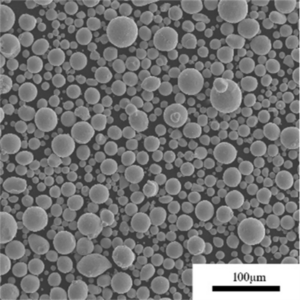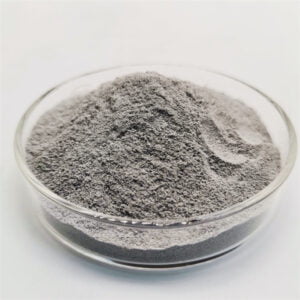Gasatomiserat metallpulver
Innehållsförteckning
Översikt över gasatomiserat metallpulver
Gasatomiserat metallpulver avser metalliska partikelmaterial som produceras genom atomisering av smält legeringsråvara med höghastighetsstrålar av inert gas. Detta ger en sfärisk morfologi som är idealisk för additiv tillverkning, formsprutning av metall och andra applikationer.
Funktioner för gasatomisering:
- Utmärkt kontroll över partikelform och storleksfördelning
- Applicerbar på reaktiva legeringar inklusive titan, aluminium
- Ger utgångsmaterial med hög renhet för avancerade processer
- Pulver skräddarsydda för isostatisk pressning och värmebehandling
- Stöder exakta repeterbara pulveregenskaper
Fortsätt läsa för att lära dig mer om sammansättningsalternativ, partikelkvaliteter, användningsområden och specifikationer för gasatomiserade pulver.

Legering Typer av gasatomiserat metallpulver
Olika legeringar kan gasatomiseras till fina sfäriska pulver:
| Legering Kategori | Material | Kompositioner |
|---|---|---|
| Rostfria stål | 304, 316, 17-4PH, 303, 410 | Fe/Cr/Ni + spårämnen |
| Verktygsstål | H13, M2, M4 | Fe + V, Mo, W karbider |
| Koboltlegeringar | CoCr, CoCrW, CoCrMo | Co/Cr + volfram/molybden |
| Nickellegeringar | Inconel 625 & 718 | Ni/Cr/Fe/Mo |
| Titanlegeringar | Ti-6Al-4V, Ti-6242 | Ti/Al/V/Sn/Zr/Mo |
Tabell 1: Översikt över legeringssystem som är kommersiellt tillgängliga i gasatomiserat pulver
Speciell additiv tillverkning och branschspecifika legeringar för användning inom flyg och biomedicin kan ha minsta orderkvantiteter eller ledtider.
Pulveregenskaper
Typiska partikelegenskaper uppnås genom atomisering med inert gas:
| Karaktäristisk | Detaljer | Betydelse |
|---|---|---|
| Partikelns form | Mycket sfärisk | Förbättrar pulverflöde och packningstäthet |
| Storleksintervall | 10 μm till 150 μm | Kontrollerad distribution optimerad för slutanvändningen |
| Sammansättning | Legering bibehållen inom ± 0,5 wt% | Bevarar mekaniska egenskaper |
| Renhet | Upp till 99,9% kan uppnås | Minskar föroreningar och inneslutningar |
| Ytoxider | <50 nm tjockt passiveringsskikt | Bibehåller utmärkt återvinningsbarhet för pulver |
Tabell 2: Översikt av partikelkvaliteter i gasatomiserade metallpulver
Exakta egenskaper produceras repeterbart för att uppfylla certifieringsbehov inom flyg-, medicin-, fordons- och industrikategorier.
Tillverkningsprocess
- Typiska steg vid atomisering med inert gas:
- Induktions- eller bågsmältning formar legeringssmältan under skyddande täckgas
- Inertgas med hög renhet (Ar eller N2) trycks genom specialiserade munstycken
- Smält ström bryts i fina droppar som snabbt kyls till pulver
- Pulvret sedimenterar i uppsamlingstrattar under
- Klassificeras via siktar för att normalisera distributionen
- Förpackas och skickas till kunder i skyddande atmosfär
- Kritiska processparametrar:
- Munstyckets utformning - styr fördelningen av partikelstorleken
- Gastryck - påverkar partikelhastigheten och kylningshastigheten
- Smältans hällhastighet - påverkar storleksfördelningens form
- Miljön (vakuum eller kontrollerad atmosfär) påverkar reaktiviteten
Tillämpningar av gasatomiserat metallpulver
| Tillämpning | Fördelar | Exempel |
|---|---|---|
| Additiv tillverkning | Delar med hög densitet tack vare utmärkt pulverflöde och packning | Komponenter för flyg- och rymdindustrin, medicinska implantat |
| Formsprutning av metall | God formbarhet för små, komplicerade former | Turbinblad, munstyckskomponenter |
| Termiska sprutbeläggningar | Täta beläggningar från deformerbara partikelimpulser | Slitstarka ytor |
| Lödpastor | Sammanfoga komplexa geometrier | Värmeväxlare, elektriska kontakter |
| Isostatisk varmpressning | Minimera förslutningsproblem med sfäriska partiklar | Konsolidering av gjutna turbinblad |
| Prekursorer för värmebehandling | Skräddarsydd kornstruktur | Utskiljningshärdande legeringar |
Tabell 3: Översikt över applikationer som utnyttjar egenskaperna hos gasatomiserade metallpulver
Den jämnhet och renhet som gasatomisering erbjuder passar de flesta avancerade metallpulverprocesser där repeterbarhet är avgörande.
Specifikationer för gasatomiserat metallpulver
Gasatomiserade pulver valideras mot olika standardspecifikationer:
| Standard | Beskrivning |
|---|---|
| ASTM B214 | Validering med hjälp av optisk mikroskopi för enhetlighet och avsaknad av satelliter |
| AMS 7008 | Materialspecifikation för flyg- och rymdindustrin inklusive atomiseringsmetod med inert gas |
| ASTM F3049 | Standardguide för karakterisering av egenskaper hos metallpulver för AM |
| ASTM F3056 | Specifikation för nickellegeringspulver för additiv tillverkning |
| ISO 21818 | Specifikation för DMLS/SLM-tillverkade rostfria stål |
Tabell 4: Industriella standarder som vanligtvis tillämpas på pulver som finfördelas med inert gas
Seriösa tillverkare tillhandahåller fullständiga certifieringshandlingar och testresultat för varje pulverparti för att validera efterlevnaden.
Leverantörer och prissättning
| Leverantör | Material | Indikativ prissättning |
|---|---|---|
| Sandvik Osprey | Ti-legeringar, Ni-legeringar, verktygsstål | $100+ per kg |
| Snickare Tillsats | Rostfria stål, koboltlegeringar, Cu | $50 - $150 per kg |
| Praxair | Ti-legeringar, Al-legeringar, kiselpulver | $100+ per kg |
| LPW-teknik | Verktygsstål, rostfria stål, Inconel | $50 - $500 per kg |
| SLM-lösningar | Utveckling av kundanpassade legeringar | $250+ per kg |
Tabell 5: Urval av företag som levererar gasatomiserade metallpulver med ungefärlig prissättning
De flesta leverantörer erbjuder standardlegeringar med 2-4 veckors ledtid i små kvantiteter. Anpassade formuleringar och unik partikeloptimering är också möjlig i direkt samarbete med leverantörer av gasatomisering.
För- och nackdelar jämfört med alternativ
| Parameter | Atomisering av gas | Atomisering av vatten | Plasmaatomisering |
|---|---|---|---|
| Partikelns morfologi | Mycket sfärisk | Mer oregelbundna sfäroider | Mestadels sfärisk |
| Fördelning av partikelstorlek | Tät distribution, skräddarsydd | Bredare spridning | Tät distribution |
| Kompatibla legeringar | De flesta kommersiella legeringar | Begränsade legeringar | Brett sortiment inklusive reaktiva metaller |
| Kostnad per kg | Måttlig $50-150 per kg | Lägre $20-100 per kg | Högre $150-500 per kg |
| Produktivitetsnivåer | Kapacitet upp till 10.000 kg per dag | Mycket hög >50.000 kg per dag | <1.000 kg per dag |
Tabell 6: Jämförelse mellan gasatomisering och alternativa pulverproduktionsmetoder
Gasatomisering ger en optimal balans mellan kapacitet och ekonomi samtidigt som den ger pulvervolymer som lämpar sig för kommersiell produktion.
Begränsningar
- Minimala batchstorlekar kräver användning av material på över 100 kg för att motivera maskininställningen
- Begränsad förmåga att ekonomiskt atomisera legeringar med hög smältpunkt som volfram
- Pulvret är inte lika sfäriskt som vid plasmaatomisering och innehåller vissa satelliter
- Oxidtjocklek något högre än alternativ med vakuumplasma
- Höga initiala kapitalkostnader på cirka $1-5 miljoner för nyckelfärdiga system
- Kräver förbättrad pulverhantering/förvaring jämfört med jungfruliga material

VANLIGA FRÅGOR
F: Vad är fördelen med gasatomiserat pulver jämfört med jungfruliga material för tillverkning av detaljer?
S: Gasatomiserade pulver ger överlägsen konsistens och repeterbarhet. Genom att konstruera pulvrets morfologi och kornstruktur från början kan man skapa mogna processer som producerar certifierade komponenter som uppfyller de högsta branschkraven inom flyg- och medicinteknik.
F: Vilka försiktighetsåtgärder krävs vid hantering av gasatomiserade pulver?
S: Eftersom fina metalliska material är benägna att oxidera rekommenderas inerta lagrings- och hanteringsprotokoll. Detta inkluderar fuktkontrollerade argonfyllda handskboxar och personal som bär personlig skyddsutrustning för att minimera risken för explosion, inandning eller kontaminering. Tillåt aldrig kontakt med vatten eller organiska föreningar. Särskild anläggningskonstruktion krävs inte nödvändigtvis, men lokala föreskrifter kan gälla.
F: Vilken nivå av repeterbarhet kan förväntas från parti till parti med gasatomiserade pulver?
S: Välrenommerade tillverkare garanterar pulverfördelningar inom ±10% mellan olika batcher. Mindre variationer motiverar ändå omoptimering som standardmetod, även från samma pulverleverantör om de acceptabla komponenttoleranserna är snäva. Analyscertifikat dokumenterar enhetligheten.
Fråga: Hur länge kan oanvända gasatomiserade pulver förbli funktionsdugliga i lager?
S: Bästa praxis är att förvara pulver i skyddande argon i slutna behållare och undvika extrema temperaturer. Om pulvret förvaras under 30 °C och 50% relativ luftfuktighet med minimalt med syre och fukt håller det i många månader innan det behöver uppdateras i handskboxen för att bibehålla flödes- och återanvändningsegenskaperna.
F: Vilken teknisk support tillhandahåller pulverleverantörerna för kvalificering och certifiering av delar?
S: Välrenommerade leverantörer har materialforskare och valideringspersonal som ger vägledning om tillämpningar och samarbetar med inköpare av komponenter genom testprocessen för att certifiera pulver. De vill ha demonstrerad repeterbarhet som uppfyller reglerade standarder för att utöka användningen av material i mer krävande applikationer. Förvänta dig detaljerat pappersarbete och protokoll från alla etablerade leverantörer.
Dela på
MET3DP Technology Co, LTD är en ledande leverantör av lösningar för additiv tillverkning med huvudkontor i Qingdao, Kina. Vårt företag är specialiserat på 3D-utskriftsutrustning och högpresterande metallpulver för industriella tillämpningar.
Förfrågan för att få bästa pris och anpassad lösning för ditt företag!
Relaterade artiklar

Högpresterande segment för munstycksvingar: Revolutionerande turbineffektivitet med 3D-utskrift i metall
Läs mer "Om Met3DP
Senaste uppdateringen
Vår produkt
KONTAKTA OSS
Har du några frågor? Skicka oss meddelande nu! Vi kommer att betjäna din begäran med ett helt team efter att ha fått ditt meddelande.

Metallpulver för 3D-printing och additiv tillverkning
FÖRETAG
PRODUKT
cONTACT INFO
- Qingdao City, Shandong, Kina
- [email protected]
- [email protected]
- +86 19116340731














